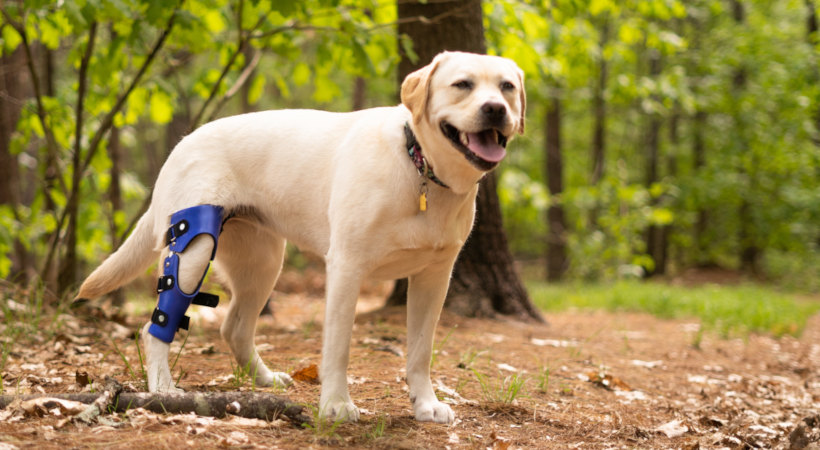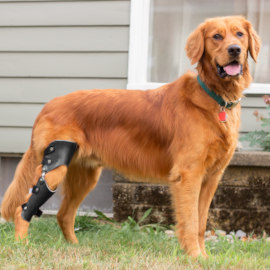How can a knee brace help my dog?
The knee or stifle joint of a dog is where the tibia meets the femur and is supported by four ligaments, the cranial cruciate ligament, the posterior cruciate, the lateral (outside), and the medial (inside) collateral ligaments. Cranial Cruciate Ligament (CCL) injuries are some of your pup’s most common injuries. The CCL is the most similar to the ACL in humans.
Wearing a stifle brace will stop excessive movement between the femur (the top half of your dog’s leg) and the tibia (the lower leg). Limiting the stretching between the upper and lower leg allows the tendon to tighten up and heal. It will also stop side-to-side rotation and give the cruciate the support it needs to heal.
How a canine knee brace works:
A knee brace is made to support the CCL to help heal the injury or prevent further damage. The knee joint is subjected to excessive motion regularly; a knee support can help control the forward slide of the tibia on the femur, which is the key function of the cranial cruciate ligament. Supporting and stabilizing the knee joint with a brace can help your dog continue their normal daily walks and play without causing harm to the CCL.
Types of dog cruciate injuries
- Rupture of the Cranial Cruciate Ligament (CCL)
- Patella Luxation
- Degeneration of the CCL
- Arthritis
- Dislocated Knee Cap
Carrying extra weight places additional stress on a dog’s joints. Dogs at risk for a knee injury or joint issues should be kept at an optimal weight to minimize their risk.
Can a dog knee brace be worn on both legs?
When a dog knee brace is worn on both hind legs, this is called bilateral bracing. A double knee brace may be necessary for a variety of reasons. Due to the high probability of a dog with an ACL or CCL tear injuring their remaining knee within a year. Further injury can be avoiding by bracing and stabilizing the uninjured knee.
For dogs with double knee injuries, supporting both stifles can reduce joint inflammation and help the pet to stay active as they heal. Knee injuries that may require bracing on both back legs include:
- Cruciate injuries or tears
- Patella luxation
- Arthritis
When should I consider using a knee brace for my dog?
If you start to notice your dog having symptoms of a knee injury, supporting the joint is a great way to help your pup until you can get to the Vet to have an exam.
Symptoms of knee injuries include:
- Limping in the hind legs.
- Joint stiffness is most noticeable when resting after physical activity.
- Difficulty jumping or getting up from the floor.
- Sitting with one leg stuck out to the side.
- Clicking sound when your dog walks.
Giving your dog’s stifle joint extra support while it is injured can help prevent a more severe injury when healing. Your dog might have a CCL tear that can be prevented from a full rupture by the use of a knee brace!
Do I need a prescription for a knee brace?
The Walkin’ Stifle brace is custom made to perfectly fit the pet’s leg and medical condition. Although a prescription is not needed, dogs needing a canine knee brace should always be seen by their vet first. Your veterinarian will assess your dog’s range of motion, overall condition, and determine of a dog knee brace is suitable for your pet.
Your vet will play a vital role in the ordering process. Every custom brace needs to start with a fiberglass impression of your dog’s back leg. A trained veterinary professional can ensure you get a good mold of your dog’s legs and that the impression is taken correctly the first time. Before ordering a stifle brace, ask your veterinarian to speak with the CPO making your brace. If the orthotist knows your dog’s diagnosis and treatment plan, the knee brace can be customized for optimal support. Even the severity of a dog’s cruciate tear can be critical in brace fabrication.
Different knee brace joints:
There are two different joint styles used in custom stifle braces, a tamarack joint or a stainless steel pivot joint. These joints coincide with the severity of the dog’s knee injury.
- Tamarack joint – a gummy, rubbery joint is a much stiffer joint. A tamarack joint is best for a complete CCL tear. The tamarack joint limits motion, allowing dogs heal a bit quicker.
- Stainless steel pivot joint – a hinged, metal joint that allows the knee to move naturally. A pivot joint is used for less severe or partial crucial tears. This style is best for when a dog needs a greater freedom of range of motion.
Helping your dog heal from a stifle joint injury
Restricting your dog’s movement immediately if you suspect a knee injury is important. Crate rest is always the safest option to prevent more harm. While you limit your dog’s activities, it may be helpful to get a body support harness to help you lift your dog as they heal! The added support of a rear harness reduces the amount of pressure on a dog’s injured joint. Getting a dog back on its feet is critical to rehabilitating from a cruciate tear or knee injury. An assistive device like a harness or dog wheelchair can improve independent mobility while taking weight off the joint.
When your dog is cleared for activity by your vet, using a knee brace when doing daily walks and playtime can help prevent re-injury. Low impact activities that don’t put too much pressure on the joint are great for rehab such as swimming or in a more clinical setting, hydrotherapy.



